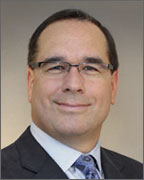Fed will report on faster payments at end of 2016

The US Federal Reserve hopes to have a report on how to create a faster payments infrastructure by the end of next year and has begun processing the 325-plus applications it has had from would-be participants in its task force for faster payments.
The deadline for applications was Friday, but Sean Rodriguez, senior vice president for industry relations at the Chicago Fed (right), said during the Nacha Payments 2015 conference this week that applications will still be accepted.
The Fed is processing the applications and doesn’t have a breakdown by geography yet, but several people have told the Fed they hope the West Coast is represented – the ACH payment system operates on East Coast hours. Each organisation can nominate just one person to the task force, and Rodriguez said it was interesting to see some organisations struggle to choose their representative. He didn’t however, name names.
Slightly more than a third (36%) of the applications are from the financial services industry, 23% from technology firms, 12% from trade groups and consumer organisations, 8% merchants, 5% payment network operators and 3% from government, including the US Treasury. Another 13% were classified as other and include academics consultants and individuals. The Fed did a little recruiting to get broad representation, Rodriguez said, adding that he wasn’t sure whether the applications included any international firms.
The faster payment initiative will use extensive collaboration to try to reach a consensus, since the Fed has no power to a mandate a change – that would require an act of Congress.
A McKinsey study for the Fed estimated the cost of a faster payment system at $4 billion to $7 billion, not including the costs to banks and other participants, such as corporates, to upgrade their systems to operate in near real-time. In a $15 trillion economy that cost doesn’t seem too large a price tag, Rodriguez added.
Organising 300-plus participants will be something of a challenge. Rodriguez said he expects a steering committee of 15, to be chosen by participants. The full task force will have meetings every quarter and phone calls once or twice a month, while the steering committee and committees will have a more intense workload.
Much of the process will be with information posted on fedpaymentsimprovement.org. Rodriguez said the Fed will use Twitter, LinkedIn and a blog to continue a dialogue. The full minutes of committee meetings will be published there.
A Fed task force on payment security has open enrolment until May 15. That will probably be an ongoing project because security threats show no sign of going away. One of its first tasks will be an inventory of security efforts by other organisations, like BITS, to make sure it does not duplicate work already underway.
Although the Fed’s approach seems heavy on talk and light on action, it is having an impact. A year ago the payments executives at two or the largest New York Banks said the existing system could meet anyone’s needs and an American Banking Association leader commenting on the Fed’s report said the fact that the existing system has lasted 40 years was proof that of its merits.
At a Fed payments meeting in Chicago just ahead of Sibos last year, speakers gave examples of the need for faster payments, such as people who had to pay a utility bill before it got shut off. Several speakers noted the number of countries – 30 to 35 depending on who was counting – that have real time or near real time payments. Perhaps the money centre banks were just embarrassed – who wants to be the last developed country to achieve real-time payments?









































